|
|
|
 |
 |
 |
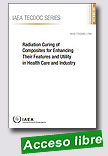 |
Radiation Curing of Composites for Enhancing Their Features and Utility in Health Care and Industry
IAEA TECDOC, 2015, 249 p.
Composite materials combine the properties of the individual components to produce a variety of materials in an efficient and cost effective manner. Composite materials are used in various applications, including sports equipment, automotive and aerospace industries, food packaging and artificial organs. Materials reinforced with nanoscale components add new dimensions to composite materials and enable further
|
major improvements in functional and structural properties. The incorporation of only a small number of nano-sized particles can result in dramatic property changes of the composite.
Several major issues need to be addressed to utilize the full potential of such nanofillers. Among them are the incompatibility or weak interfacial bonding between the matrix and the nanoscale component, and the agglomeration of nano-sized component during processing, resulting in inhomogeneous distribution. According to the results of ongoing investigation and product preparation at several Member State institutions, radiation technology offers a way of overcoming these challenges by grafting appropriate monomers and polymers onto the nanofiller surface, thereby fixing their morphology and making them compatible with the host
polymer. Radiation techniques also offer the possibility for simultaneous synthesis of the nanoparticle component and crosslinking of the matrix of the composite, which is not possible with other techniques. With the availability of lower cost, self-shielded low energy electron beam accelerators, this process is becoming an option for developing countries.
In order to use the advantages of radiation techniques and to address the needs of Member States producing advanced composite materials, the Coordinated Research Project (CRP) on Radiation Curing of Composites for Enhancing their Features and Utility in Health Care and Industry supported participating institutions in the development of methodologies and protocols for new abrasion resistant coating formulations, radiation curable nanocomposites from natural polymers, new biodegradable packaging materials suitable for radiation sterilization and new methods to modify surface characteristic of nano-sized materials to enhance polymer fillers interaction. This CRP provided a forum for knowledge and technology transfer among the participating institutions, and promoted early involvement of developing countries in knowledge intensive R&D programmes. This publication is the final report of the CRP, with detailed reports from each participating institution.
Extraído de: http://www-pub.iaea.org/books/IAEABooks/10842/Radiation-
Curing-of-Composites-for-Enhancing-Their-
Features-and-Utility-in-Health-Care-and-Industry
|
 |
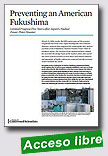 |
Preventing an American Fukushima
Union of Concerned Scientists, March 2016, 18 p.
March 11, 2016, marks the fifth anniversary of the massive magnitude 9.0 Great East Japan Earthquake and resultant 15-meter tsunami that triggered the catastrophic 2011 nuclear accident at the Fukushima Dai-ichi Nuclear Power Plant in northern Japan. The severity of the natural disaster—which far exceeded the design basis of the nuclear plant and caused the cores of three reactors to melt down and release substantial
quantities of highly radioactive material into the |
environment—stunned the world.
In response to the accident, the US Nuclear Regulatory Commission (NRC), which regulates the US nuclear power industry, established a task force to recommend actions that the NRC should take in the near term to improve the safety of US nuclear power plants against flooding or other extreme events that may exceed their design basis—important because many US nuclear plants are in floodprone or seismically active locales. The Near-Term Task Force—which consisted of a group of senior NRC staff—issued a 96-page report in July 2011 with 12 detailed multi-part recommendations (Task Force 2011). The task force then binned the recommendations into three tiers, with Tier 1 being the highest priority.
While not exhaustive, the task force recommendations provided a strong first step for reducing the likelihood of a beyond-design-basis, Fukushima-scale accident in the United States.
The fifth anniversary of the Fukushima accident provides a good opportunity to take stock of the progress—or lack thereof—made by the NRC and the nuclear industry in carrying out the report’s recommendations and in addressing the safety problems identified by the task force, other NRC staff, and independent groups, including the Union of Concerned Scientists (UCS) (Lochbaum and Lyman 2012.
Extraído de: http://www.ucsusa.org/sites/default/files/attach/2016/03/Preventing-American-Fukushima-full-report.pdf
|
 |
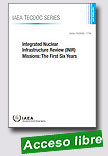 |
Integrated Nuclear Infrastructure Review (INIR) Missions: The First Six Years
IAEA TECDOC, 2015, 58 p.
IAEA Integrated Nuclear Infrastructure Review (INIR) missions are designed to assist Member States in evaluating the status of their national infrastructure for the introduction of a nuclear power programme. INIR missions are conducted upon request from the Member State. Each INIR mission is coordinated and led by the IAEA and conducted by a team of IAEA staff and international experts drawn from Member States
|
which have experience in different aspects of developing and deploying nuclear infrastructure.
INIR missions cover the 19 infrastructure issues described in Milestones in the Development of a National Infrastructure for Nuclear Power, IAEA Nuclear Energy Series No. NG-G-3.1, published in 2007 and revised in 2015, and the assessment is based on an analysis of a self-evaluation report prepared by the Member State, a review of the documents it provides and interviews with its key officials. Phase 1 INIR missions evaluate the status of the infrastructure to achieve Milestone 1 (Ready to make a knowledgeable commitment to a nuclear power programme). Phase 2 INIR missions evaluate the status of the infrastructure to achieve Milestone 2 (Ready to invite bids/negotiate a contract for the first nuclear power plant).
From 2009 to 2014, 14 IAEA INIR missions and follow-ups were conducted in States embarking on a nuclear power programme and one State expanding its programme. During this time, considerable experience was gained by the IAEA on the conduct of INIR missions, and this feedback has been used to continually improve the overall INIR methodology. The INIR methodology has thus evolved and is far more comprehensive today than in 2009.
Despite the limited number of INIR missions conducted, some common findings were identified in Member States embarking on nuclear power programmes. This publication summarizes the results of the missions and highlights the most significant areas in which recommendations were made.
Extraído de: http://www-pub.iaea.org/books/IAEABooks/10957/Integrated-Nuclear-Infrastructure-Review-INIR-Missions-The-First-Six-Years
|
 |
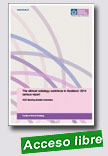 |
Radiology departments across Scotland are facing considerable difficulties in the provision of safe, high-quality diagnostic and interventional services. The report draws on the data collected through the RCR 2014 workforce census, highlighting the significant workforce problems and increasing demands placed on radiology services in Scotland.
|
Extraído de: https://www.rcr.ac.uk/publication/clinical-radiology-workforce-scotland-2014-census-report |
 |
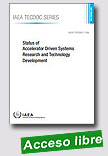 |
Status of Accelerator Driven Systems Research and Technology Development
IAEA TECDOC, 2015, 378 p.
The objective of this status report is threefold. Firstly, it aims to review the state of the art of this technology by presenting the different ADS concepts proposed worldwide since 2000, as well as the related R&D activities and demonstration initiatives carried out at national and international levels. Secondly, it contributes to establishing an international roadmap up to the full deployment of ADS, in the context of advanced nuclear fuel
|
cycles. Thirdly, it helps to identify and possibly to stimulate important directions of national and international efforts in this area.
Extraído de: https://www.rcr.ac.uk/publication/sustainable-future-diagnostic-radiology-introduction
|
 |
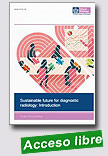
|
Sustainable future for diagnostic radiology: introduction
The Royal College of Radiologists (RCR - UK), 2015, 6 p.
With an increase in demand for complex imaging and a national shortage of radiologists, services in the UK are facing great challenges. The priority for the NHS remains to deliver to patients an accurate and timely interpretation of their images in the most efficient and effective way.
The Royal College of Radiologists has developed a set of guidance documents which suggest ways which would allow more flexible working, with potentially greater specialisation and job satisfaction. |
Extraído de: https://www.rcr.ac.uk/publication/sustainable-future-diagnostic-radiology-introduction
|
 |
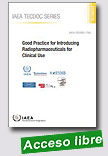 |
Good Practice for Introducing Radiopharmaceuticals for Clinical Use
IAEA TECDOC, 2016, 84 p.
The use of new radiopharmaceuticals can provide extremely valuable information in the evaluation of cancer, as well as heart and brain diseases. Information that often times cannot be obtained by other means. However, there is a perceived need in many Member States for a useful reference to facilitate and expedite the introduction of radiopharmaceuticals already in clinical use in other countries. This publication intends to |
provide practical support for the introduction of new radiotracers, including recommendations on the necessary steps needed to facilitate and expedite the introduction of radiopharmaceuticals in clinical use, while ensuring that a safe and high quality product is administered to the patient at all times.
Extraído de: http://www-pub.iaea.org/books/IAEABooks/10829/Good-Practice-for-Introducing-Radiopharmaceuticals-for-Clinical-Us
|
 |
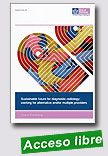 |
Sustainable future for diagnostic radiology: working for alternative and/or multiple providers
The Royal College of Radiologists (RCR - UK), 2015, 11 p.
As demand for radiology services in the UK increases, the market of providers is becoming more complex. Radiologists have the opportunity to work outside of the NHS, for multiple providers or in self-employment.
This guidance document explores the opportunities available to radiologists and highlights the potential areas of risk, including conflict of interest, revalidation and clinical governance.
|
Extraído de: https://www.rcr.ac.uk/publication/sustainable-future-diagnostic-radiology-working-alternative-andor-multiple-providers
|
 |
|
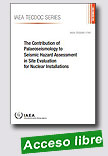
|
The Contribution of Palaeoseismology to Seismic Hazard Assessment in Site Evaluation for Nuclear Installations
IAEA TECDOC, 2015, 212 p.
In the framework of site evaluation/re-evaluation procedures for nuclear power plants and other nuclear installations, this publication aims at encouraging and supporting Member States, especially from newcomer countries, to include paleoseismic investigations into the geologic database.
In fact, paleoseismology is not just a crucial discipline for Fault Displacement Hazard Assessment (FDHA) but also an .
|
indispensable tool for Seismic Hazard Assessment (SHA), as recommended in the reference IAEA Safety Guide (IAEA SSG-9 [1]).
Within this scope, this document provides an updated review of the state of the art of paleoseismology, integrated with practical recommendations addressed to Member States, aiming to emphasize the value of earthquake geology studies for nuclear safety.
Paleoseismic investigations in the context of site evaluation of nuclear installations, as described in the IAEA SSG-9 [1], have the following main objectives: Identification of seismogenic structures based on the recognition of effects of past earthquakes in the region; Improvement of the completeness of earthquake catalogs, through the identification and dating of ancient moderate to large earthquakes, whose trace has been preserved in the geologic record; Estimation of the maximum seismic potential associated with an identified seismogenic structure/source, typically on the basis of the amount of displacement per event (evaluable in paleoseismic trenches), as well as of the geomorphic and stratigraphic features interpretable as the cumulative effect of repeated large seismic
events (concept of ‘seismic landscape’); Rough calibration of probabilistic seismic hazard assessment (PSHA), by using the recurrence interval of large earthquakes detectable by paleoseismic investigations, and providing a ‘reality check’ based on direct observations of earthquake environmental effects
Extraído de: http://www-pub.iaea.org/books/IAEABooks/10887/The-Contribution-of-Palaeoseismology-to-Seismic-Hazard-Assessment-in-Site-Evaluation-for-Nuclear-Installations
|
 |
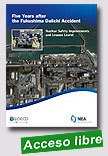 |
Five Years after the Fukushima Daiichi Accident: Nuclear Safety Improvements and Lessons Learnt
Nuclear Energy Agency (NEA), 29/02/16, 80 p.
Since the Fukushima Daiichi nuclear power plant accident, the principal NEA standing technical committees with responsibilities in the areas of regulatory oversight, nuclear safety, radiological protection and public health, and nuclear liability – the Committee on Nuclear Regulatory Activities (CNRA), the Committee on the Safety of Nuclear Installations (CSNI), the Committee on Radiation Protection and Public
|
Health (CRPPH) and the Nuclear Law Committee (NLC) – have been closely co-ordinating their activities in these areas. As part of these efforts, a report entitled The Fukushima Daiichi Nuclear Power Plant Accident: OECD/NEA Nuclear Safety Response and Lessons Learnt was published (NEA, 2013c), detailing the immediate response of the NEA and its member countries to the accident.
Among the key findings, the 2013 report underlined that member countries had performed focused safety reviews of their operating reactors and had determined that they were safe to continue operations while more comprehensive safety reviews were conducted to identify work needed to further improve safety.
Five Years after the Fukushima Daiichi Accident: Nuclear Safety Improvements and Lessons Learnt provides an update on these activities and lessons learnt, including: i) activities undertaken by regulatory authorities in NEA member countries which have led to the establishment of new requirements resulting in specific nuclear power plant improvements in multiple areas; ii) activities to improve the regulatory framework in member countries; iii) research activities to acquire additional knowledge and understanding of the accident itself; iv) activities implemented to improve emergency preparedness and radiological protection; and v) legal improvements, including those in the area of liability law. The report focuses on actions taken by the NEA and its member countries, and as such, is complementary to reports produced by other international organisations, including the International Atomic Energy Agency (IAEA) and the World Association of Nuclear Operators (WANO).
Executive summary | Report
Extraído de: http://www.oecd-nea.org/nsd/pubs/2016/7284-five-years-fukushima.pdf
|
 |
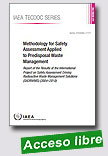 |
Methodology for Safety Assessment Applied to Predisposal Waste Management
IAEA TECDOC, 2016, 184 p.
Report of the Results of the International Project on Safety Assessment Driving Radioactive Waste Management Solutions (SADRWMS) (2004–2010) The IAEA’s progamme on Safety Assessment Driving Radioactive Waste Management Solutions (SADRWMS) focused on approaches and mechanisms for application of safety assessment
|
methodologies for the predisposal management of radioactive waste. The initial outcome of the SADRWMS Project was achieved through the development of flowcharts, which have since been incorporated into IAEA Safety Standards Series No. GSG-3, Safety Case and Safety Assessment for Predisposal Management of Radioactive Waste. In 2005, an initial specification was developed for the Safety Assessment Framework (SAFRAN) software tool to apply the SADRWMS flowcharts. In 2008, an in-depth application of the SAFRAN tool and the SADRWMS methodology was carried out on the predisposal management facilities of the Thailand Institute of Nuclear Technology Radioactive Waste Management Centre (TINT Facility). This publication summarizes the content and outcomes of the SADRWMS programme. The Chairman’s Report of the SADRWMS Project and the Report of the TINT test case are provided on the CD-ROM which accompanies this report.
Extraído de: http://www-pub.iaea.org/books/IAEABooks/10938/Methodology-for-Safety-Assessment-Applied-to-Predisposal-Waste-Management
|
 |
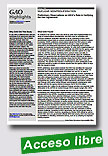 |
Nuclear Nonproliferation: Preliminary Observations on IAEA's Role in Verifying the Iran Agreement
Government Accountability Office (GAO-US), February 12, 2016, 27 p.
In July 2015, multilateral talks with Iran culminated in an agreement called the Joint Comprehensive Plan of Action (JCPOA), through which Iran committed to limits on its nuclear program in exchange for relief from sanctions put in place by the United States and other nations. The International Atomic
|
Energy Agency (IAEA), an independent international organization that administers safeguards designed to detect and deter the diversion of nuclear material for non-peaceful purposes, was requested to monitor and verify Iran’s adherence to these limits. The U.S. Department of State coordinates the United States’ financial and policy relationship with IAEA.
GAO was asked to review the authorities and resources IAEA has to carry out its activities regarding the JCPOA. On the basis of preliminary results of ongoing work that GAO is conducting, this report provides observations on (1) the JCPOA commitments that IAEA has been asked to verify and its authorities to do so, (2) the resources IAEA has identified as necessary to verify the JCPOA, and (3) potential challenges and mitigating actions IAEA and others have identified with regard to verifying the JCPOA. GAO analyzed the JCPOA and key IAEA documents and interviewed current and former IAEA officials, U.S. government officials, national laboratory representatives, and experts from research institutions.
GAO is not making recommendations at this time and expects to issue a final report on this work later this year.
Highlights | Report
Extraído de: http://www.gao.gov/assets/680/675223.pdf
|
| |
| |
|
|
| |
|
|
|
|
|
